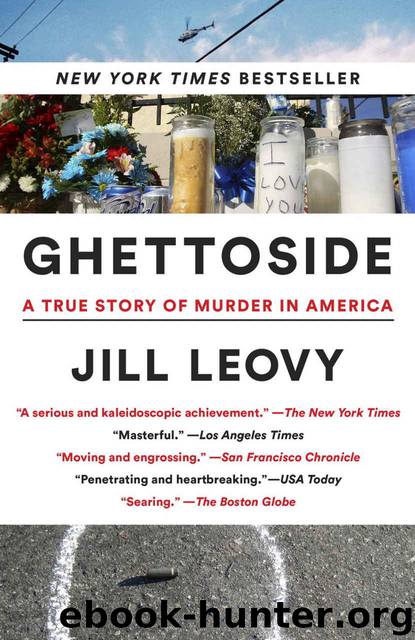Ghettoside: A True Story of Murder in America by Jill Leovy

Author:Jill Leovy [Leovy, Jill]
Language: eng
Format: azw3
ISBN: 9780385529990
Publisher: Random House Publishing Group
Published: 2015-01-27T05:00:00+00:00
17
BABY MAN
Devin Davis was seventeen in the first weeks of 2008. He was an awkward-looking kid with a large head, high round cheeks, and very round, large brown eyes. He was afflicted with ADHD and high blood pressure—a diagnosis rare in teenagers but not uncommon in South Central. His wrist was injured from a gunshot months before.
Devin appeared to be constantly on the lookout for something to guffaw at, in the anxious way of teenagers who fear being left out of a joke. But he was not cheerful. His eyes had a plaintive expression. His affect was peevish and unhappy.
When the probationer first uttered Devin’s moniker Baby Man to Skaggs, Skaggs was pretty sure Devin was the killer. Then Midkiff fingered his photo, identifying Devin as the “crazy boy” in the back of the Suburban, and Skaggs was certain. He intended to come right at Devin, plunging forward, as always, in the straightest possible line.
Devin’s imprisonment gave him time to prepare. Skaggs wanted every advantage. The interrogation of Devin Davis would be the most important juncture in this most important of cases; it would be the pivotal moment in his whole career.
Skaggs knew what he wanted from Devin—a full confession. In his mind, he had already constructed the outlines of a case built solely on the accounts of the man in the wheelchair, the probationer, and Midkiff, supported by corroborating evidence. But he knew the case would be far stronger with a confession.
Skaggs had interrogated hundreds of murder suspects, and a striking number had confessed, at least partially. This was not entirely a tribute to Skaggs’s talent: confessions were astonishingly common in ghettoside cases. Sal La Barbera maintained he’d gotten some version of a confession on almost every case he had ever cleared. Perhaps not in the actual interrogation, but in the long waits in between—during meals, or while being processed for arrest—young men nearly always let something slip. It was relatively rare for suspects in gang cases to invoke their right to an attorney.
Skaggs couldn’t understand why suspects confessed. But La Barbera, who ascribed sentimental motives to everyone—even murderers—had a theory. He believed it was the burden of guilt. Murder, he suggested, had a kind of existential weight; one had to be very hardened indeed not to be bested by it. Other detectives had similar notions. Brent Josephson, the old ghettoside hand from the previous generation, had a memorable story from the peak years. It involved a scoop-and-carry homicide case in a park. Assigned after the fact, with the evidence cleared away and no witnesses, Josephson was standing helplessly at the scene, thinking he didn’t have a prayer of solving the case, when he noticed a skinny Hispanic youth in the distance. Josephson called out to him, thinking the kid might have some pointers. Thunderstruck, the young man hung his head and shuffled over. “You got me,” he told Josephson, and proceeded to confess. The specter of an LAPD detective beckoning from across the park had apparently been too much for him.
Download
This site does not store any files on its server. We only index and link to content provided by other sites. Please contact the content providers to delete copyright contents if any and email us, we'll remove relevant links or contents immediately.
| Anthropology | Archaeology |
| Philosophy | Politics & Government |
| Social Sciences | Sociology |
| Women's Studies |
Nudge - Improving Decisions about Health, Wealth, and Happiness by Thaler Sunstein(7260)
iGen by Jean M. Twenge(5166)
The Fire Next Time by James Baldwin(5024)
Adulting by Kelly Williams Brown(4240)
The Hacking of the American Mind by Robert H. Lustig(4093)
The Sports Rules Book by Human Kinetics(4079)
The Ethical Slut by Janet W. Hardy(4042)
Captivate by Vanessa Van Edwards(3732)
Mummy Knew by Lisa James(3522)
In a Sunburned Country by Bill Bryson(3375)
The Worm at the Core by Sheldon Solomon(3328)
Ants Among Elephants by Sujatha Gidla(3282)
Suicide: A Study in Sociology by Emile Durkheim(2908)
The Slow Fix: Solve Problems, Work Smarter, and Live Better In a World Addicted to Speed by Carl Honore(2843)
The 48 laws of power by Robert Greene & Joost Elffers(2818)
Humans of New York by Brandon Stanton(2694)
Handbook of Forensic Sociology and Psychology by Stephen J. Morewitz & Mark L. Goldstein(2606)
The Happy Hooker by Xaviera Hollander(2586)
The Tipping Point by Malcolm Gladwell(2565)
